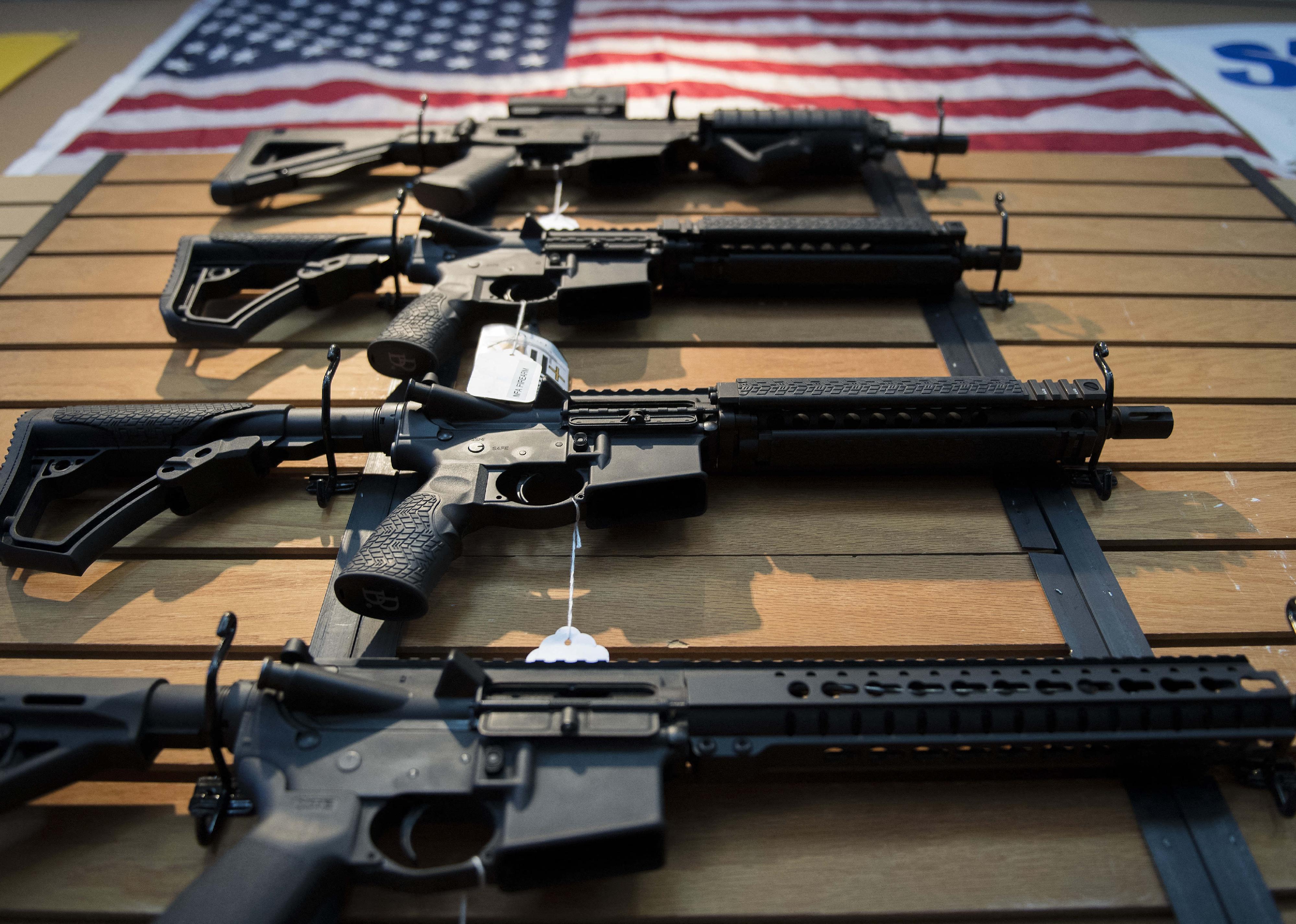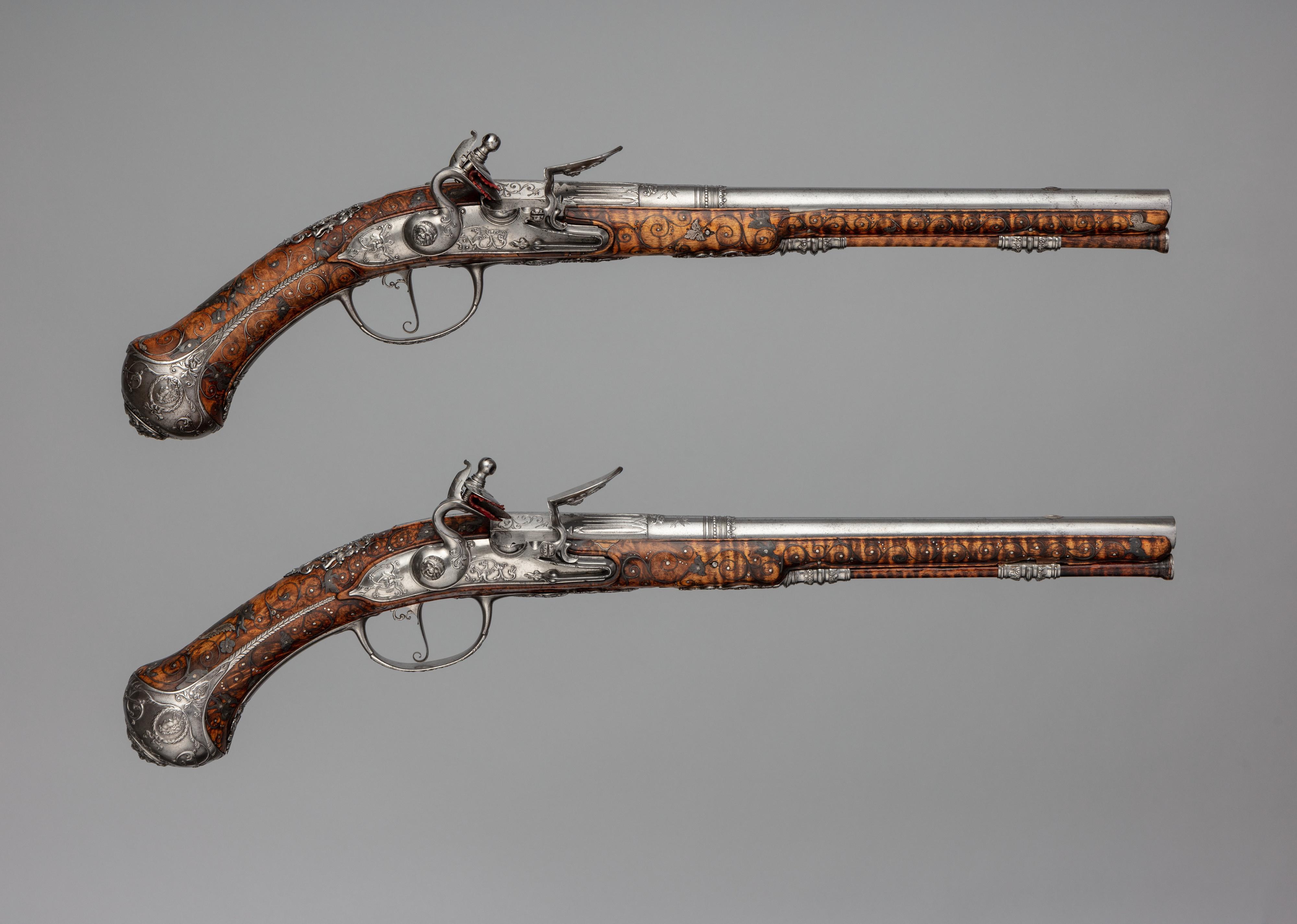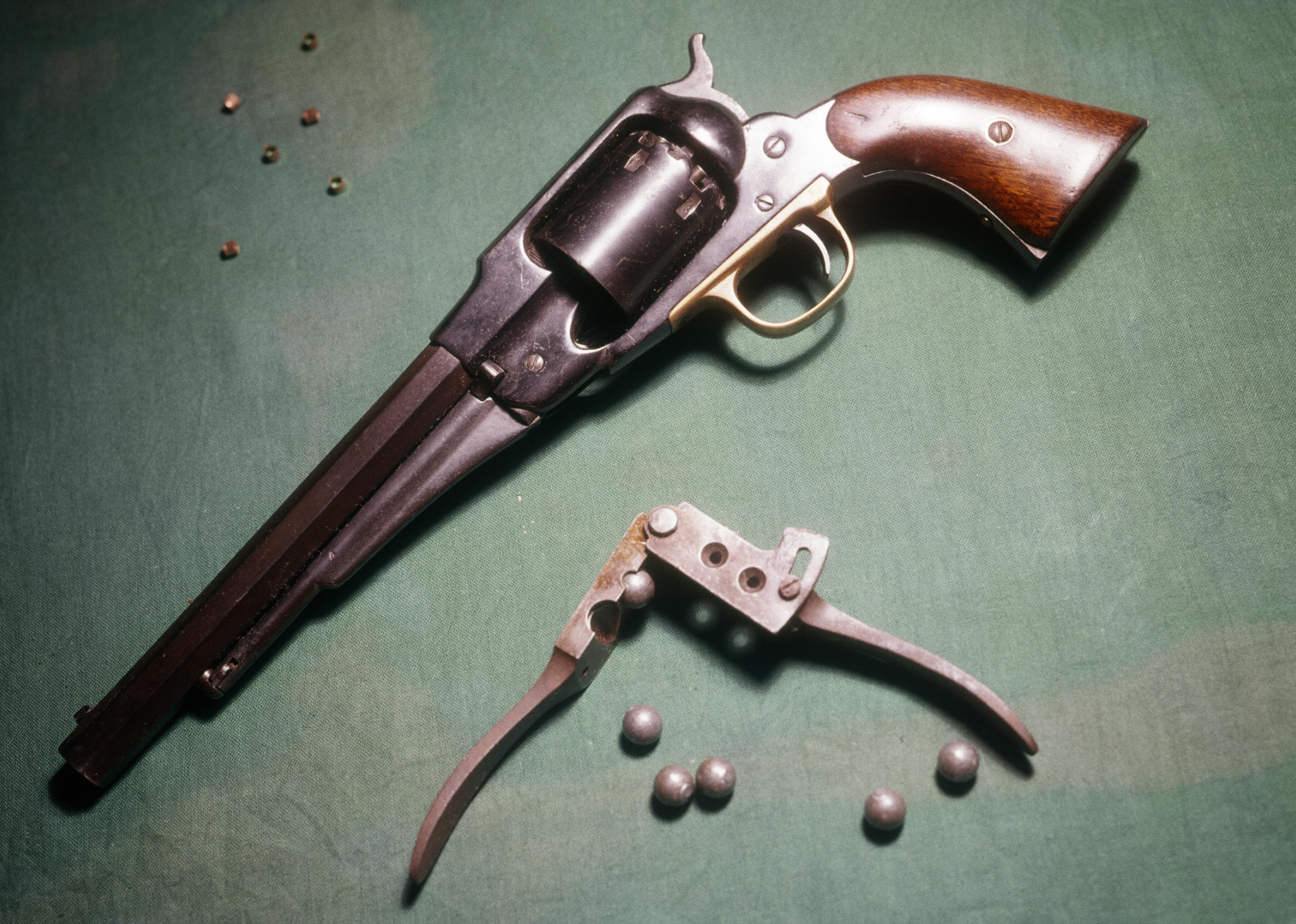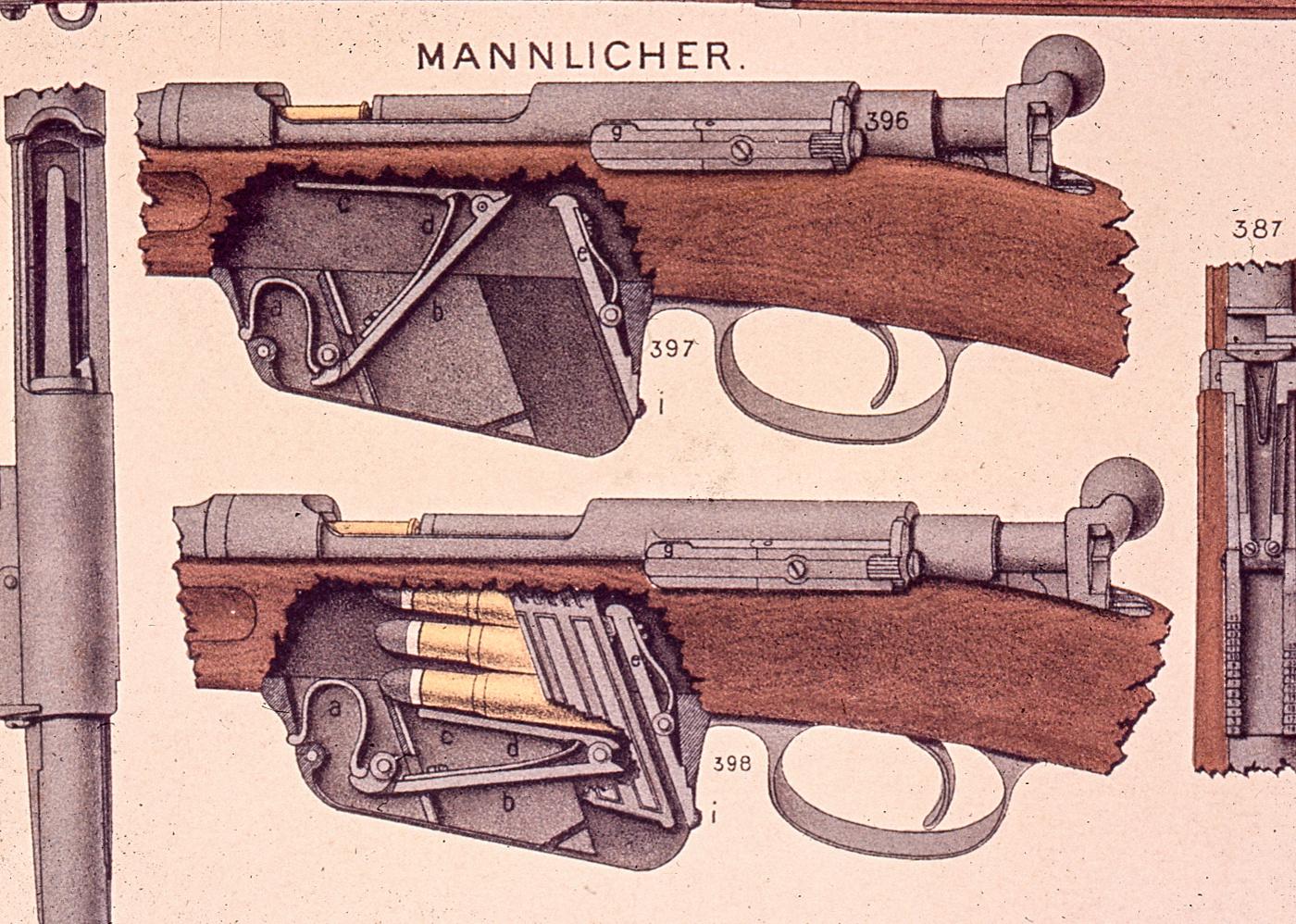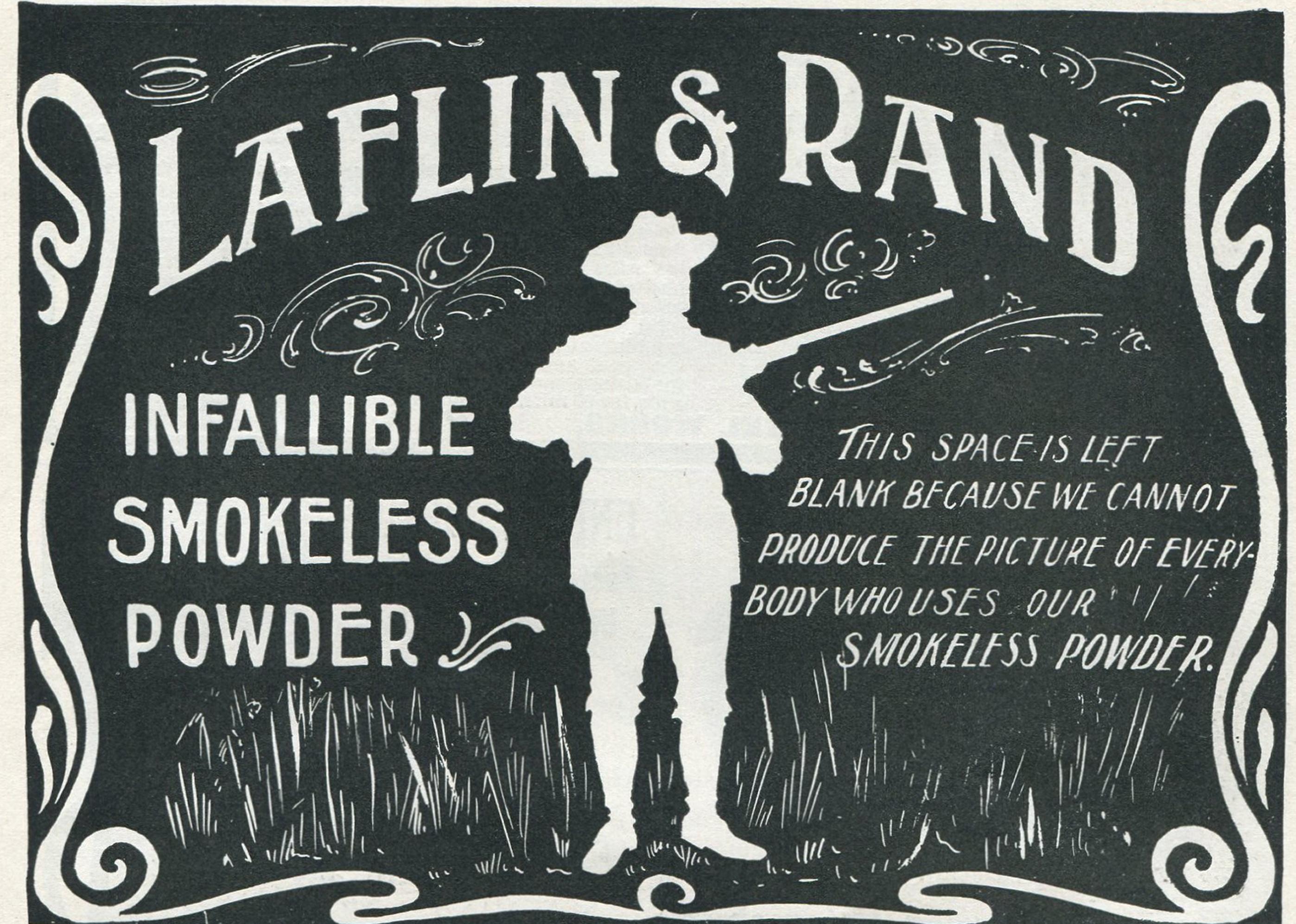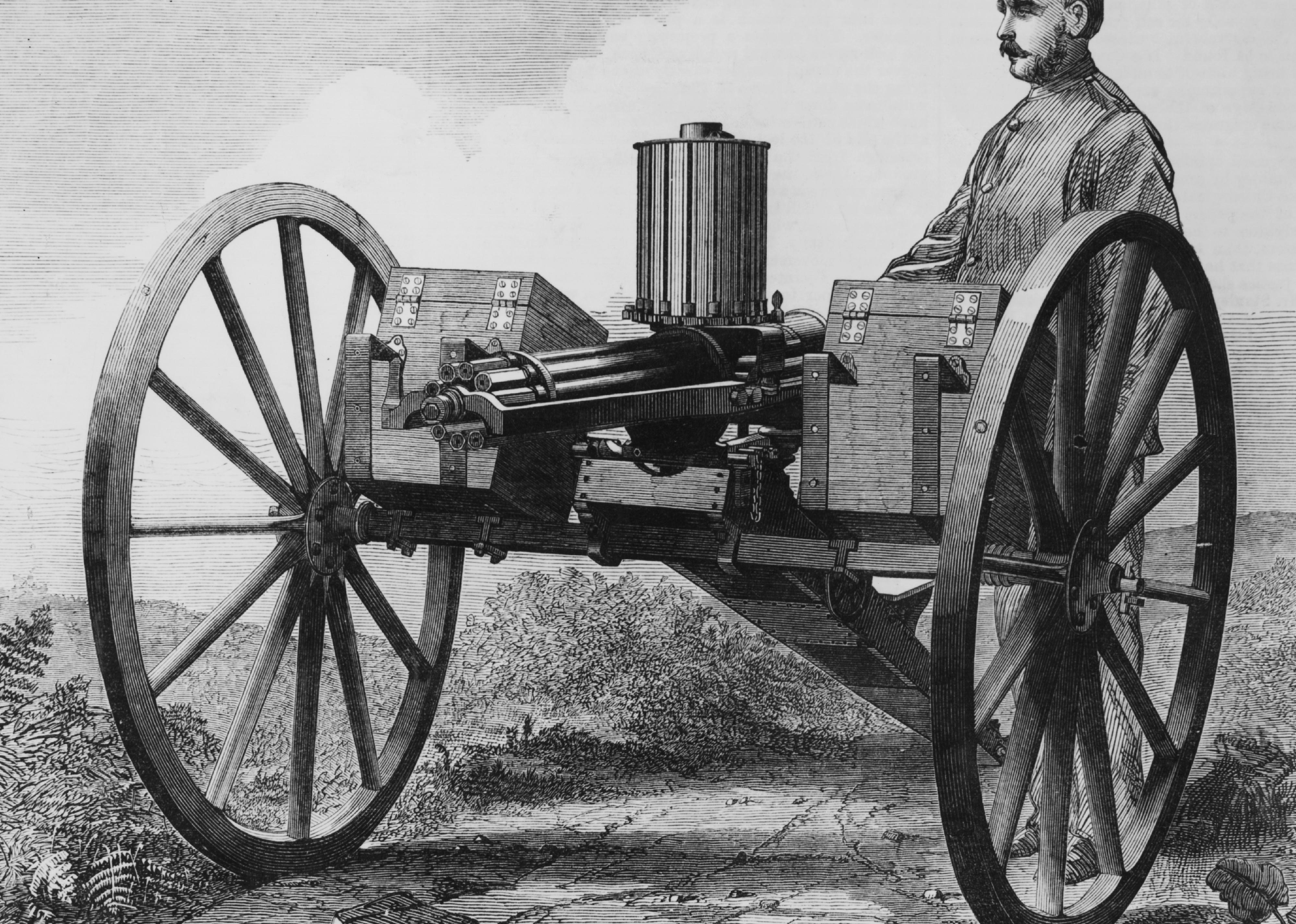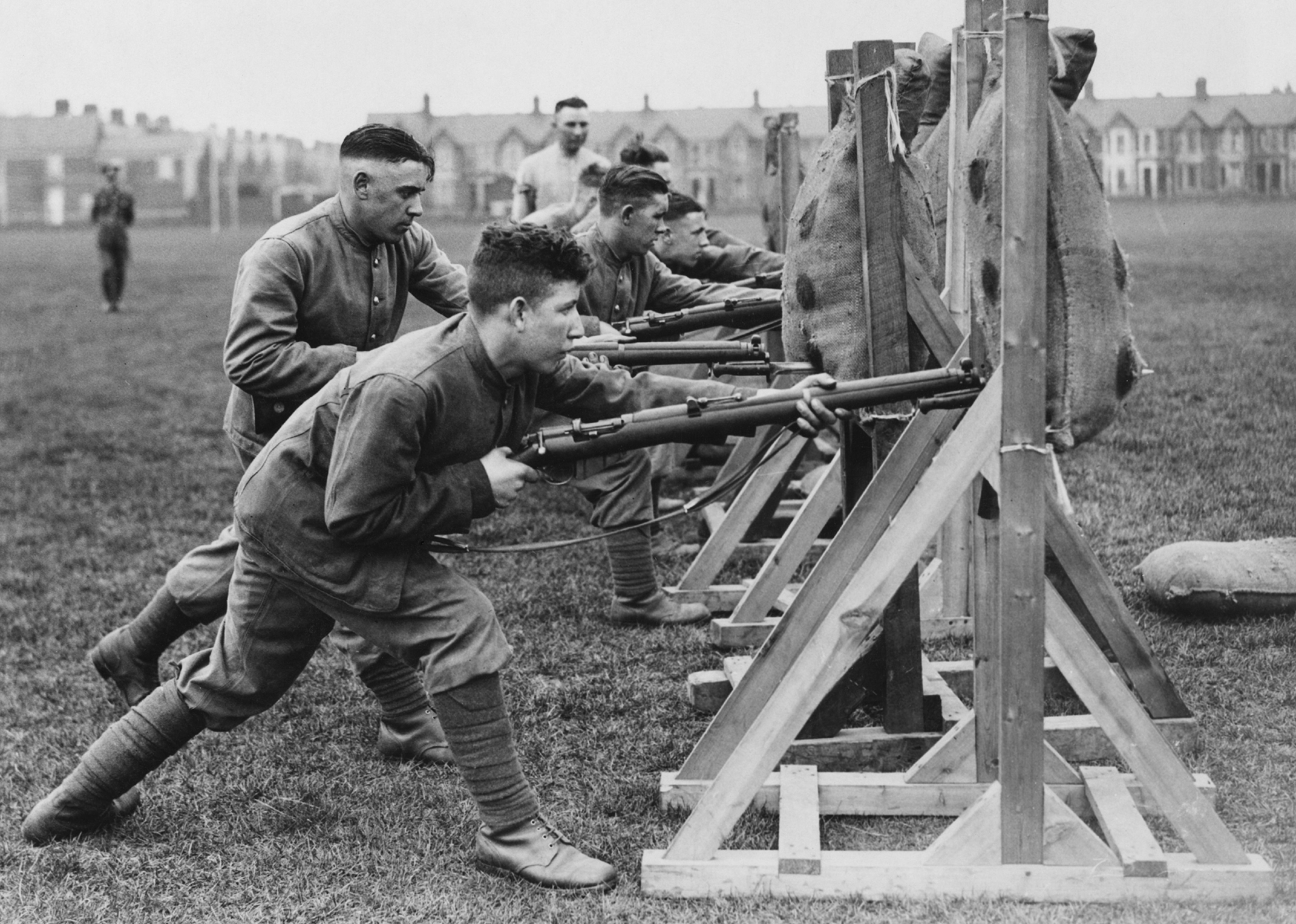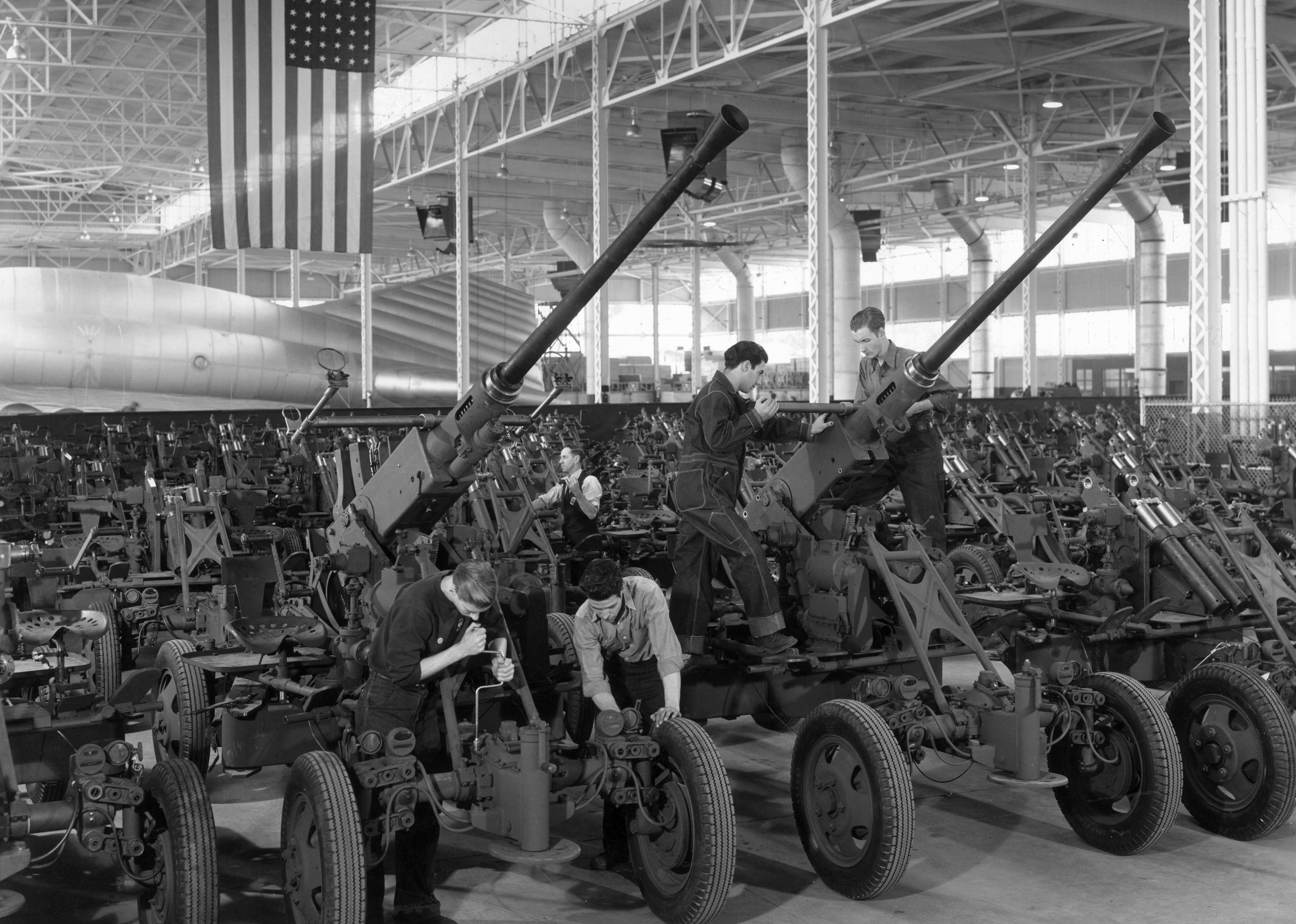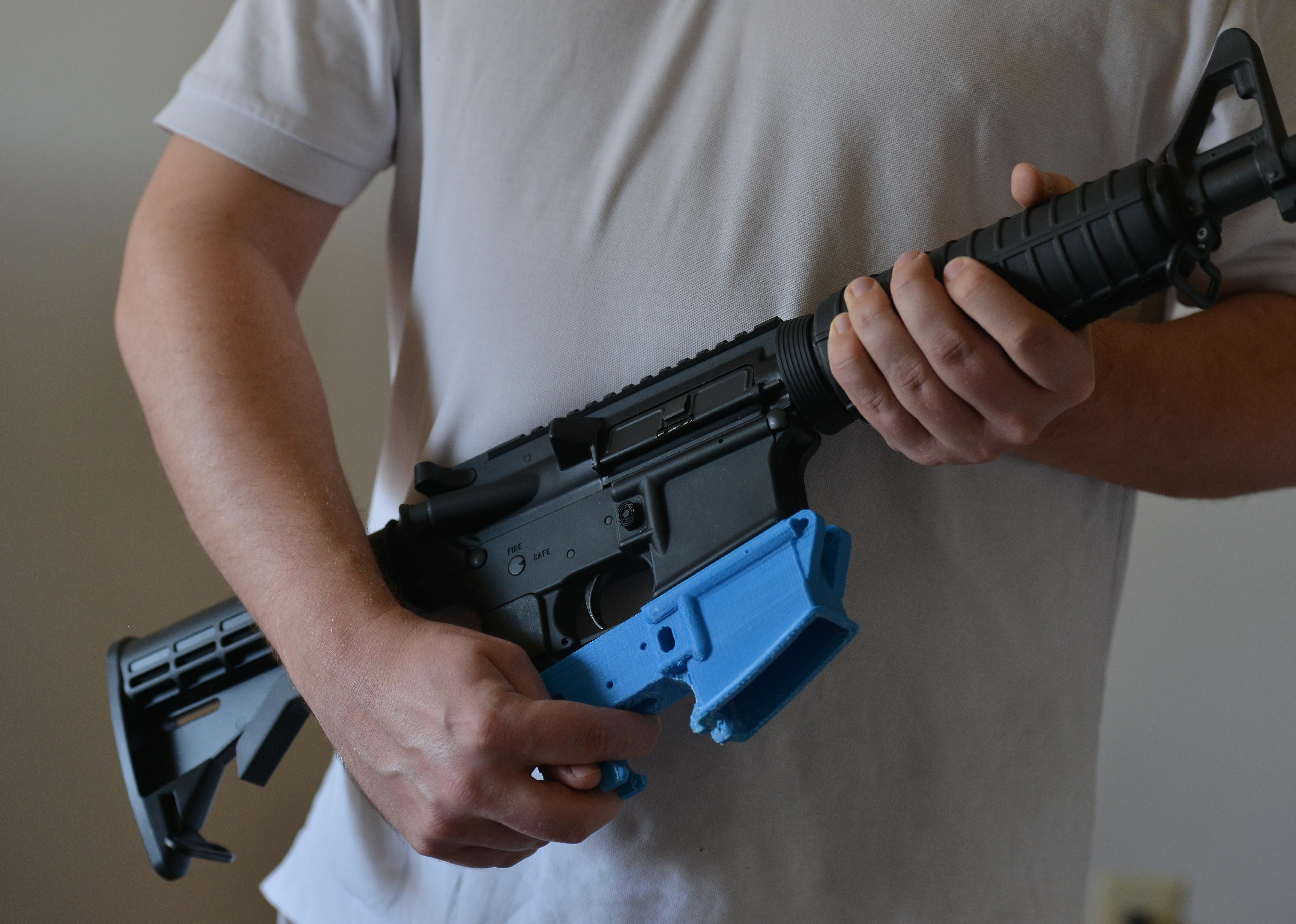From flintlock muskets to AR-15s: A history of guns in America
JIM WATSON // Getty Images
From flintlock muskets to AR-15s: A history of guns in America
Assault rifles hang on the wall for sale at Blue Ridge Arsenal in Chantilly, Virginia.
When it comes to symbols of American culture, guns are right up there with apple pie and baseball. Firearms have held an enduring role in the development of American society dating back to the Revolutionary War, but their cultural significance extends well beyond military use. American civilians own over 393 million guns, according to the 2017 Small Arms Survey. The exact number is difficult to pinpoint given the proliferation of unregulated sales and manufacture through innovations such as 3D printing.
For better or for worse, however, it is inarguable that the United States is the only country with more civilian-owned firearms than people. Whether they own them for personal protection or sport, many gun enthusiasts consider firearm ownership an essential tenet of American freedom. Meanwhile, those favoring more regulation are concerned by recent trends indicating looser gun restrictions are directly correlated with more mass shootings and firearm homicides.
In light of the enduring gun debates that have permeated the political stage in recent decades, Stacker compiled a list of 10 key moments in the development of firearm technology throughout the history of the U.S. from archives, patent records, historical resources, and news publications.
![]()
Heritage Images // Getty Images
Flintlock muskets
Pair of Flintlock Pistols made for Christian Ernst.
Appearing for the first time in 1630, the flintlock musket introduced an improved ignition method to existing firearm mechanisms. Where previous models relied on a slow-burning match to ignite the gunpowder, the flintlock musket strikes a piece of flint, a derivative of quartz, against an iron pan. This made the gun more reliable in wet conditions, quicker to reload, and less likely to misfire. The gun soared in popularity for the next 200 years, becoming the “go-to” firearm for American militaries until the invention and mass adoption of the percussion cap system.
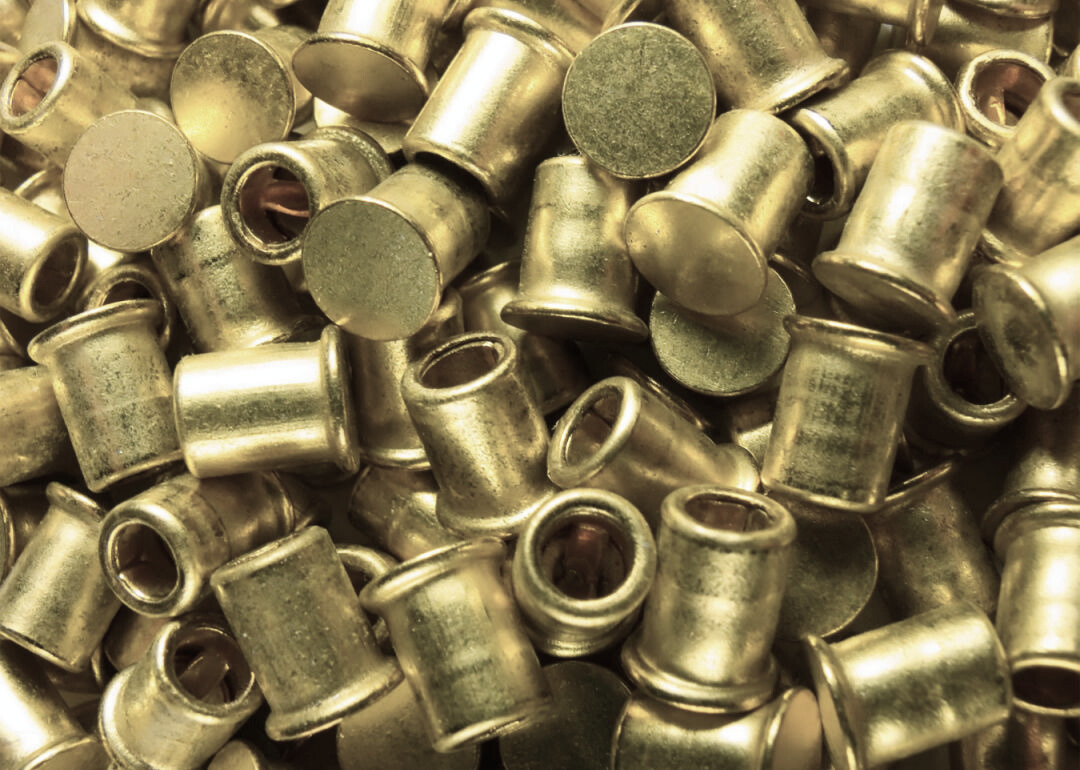
Muzhik // Shutterstock
Percussion caps
A pile of percussion caps.
In 1805, Rev. Alexander John Forsyth pioneered the next mass innovation in firearms after becoming frustrated by the flintlock musket’s tendency to startle prey during hunting. The percussion cap ignition method activates when the gun’s hammer strikes the percussion cap, igniting the gunpowder. This shortened the interval between pulling the trigger and firing the bullet and was also more reliable in various environmental conditions. While the use of percussion caps in guns quickly became obsolete owing to later innovations, the system served as a basis for modern-day cartridges, grenades, and flare guns.
ClassicStock // Getty Images
Revolvers
1858 Cap & Ball Percussion Revolver with lead bullets caps and mold.
The revolver was one of the first firearm models to significantly improve upon the rate of fire. Because the handgun contains multiple chambers for cartridges, users do not need to reload after each firing. While the very first revolver mechanism is thought to have been invented sometime in the 16th century, it wasn’t until 1836—when American Samuel Colt patented a more practical and cost-effective design—that the firearm took off in popularity. In his model, the cylinder is automatically rotated after firing, and empty cases are ejected once the cylinder is opened.
API // Getty Images
Repeating rifles
Drawing of the mechanisms in a Mannlicher M1895.
Like revolvers, repeating rifles allow users to fire multiple shots without reloading but do not contain a cylinder. Instead, a magazine underneath the barrel holds rounds automatically loaded into the barrel with a spring. American businessman Oliver Winchester popularized the firearm through his company, the Winchester Repeating Arms Company, which created the Winchester Model 1873, colloquially known as “The Gun That Won the West.”
Jay Paull // Getty Images
Smokeless powder
Advertisement for Laflin & Rand smokeless gun powder, 1902.
While a reliable explosive, earlier forms of gunpowder posed several problems for firearm users. It left behind a significant amount of smoke, obscuring the user’s vision until it cleared; left bore deposits within the firearm, requiring frequent cleaning; and tended to clog moving parts. This inspired several attempts throughout the 19th century to create a smokeless powder to varying degrees of success. In 1884, however, French chemist Paul Vieille created Poudre B, a nitrocellulose-based powder that left little residue, fired reliably, and served as the basis for smokeless powder by military powers worldwide.
Hulton Archive // Getty Images
Automatic firearms
Illustration of a soldier with a Gatling gun.
In the early 1860s, Richard Gatling invented the first manually operated machine gun, the Gatling gun. The gun’s ten barrels could be fired and ejected within one rotation of the hand crank.
Later, when the United States entered World War I, the need for rapid rearmament with domestic weapons became apparent when surplus arms from foreign countries proved inadequate, inspiring John Browning to invent the Browning automatic rifle. The rifle was initially considered a lightweight machine gun well-suited for trench warfare. Still, its implementation revealed it was too big and fired too slowly for its intended purpose. This led John Thompson to create the Thompson submachine gun, or “Tommy gun,” which produced a high volume of automatic fire in a short time frame. The United States Army adopted the gun in 1928, which then surged in popularity during World War II.
Richards // Getty Images
Bolt-action rifles
Soldiers undertake bayonet thrust practice against straw filled dummies using a bolt action rifle.
Bolt-action rifles may date back to the 19th century, but the firearm didn’t gain widespread adoption until World War I, when it became the most widely used firearm among troops. The bolt-action design combines several moving components into one action, offering improved accuracy and reliability. While semi-automatic rifles eventually replaced bolt-action rifles as the standard combatant weapon, they remain the preferred firearm among snipers and hunters. This is because, besides its high accuracy, it can accommodate longer and more powerful cartridges.
Hulton Archive // Getty Images
Polymer manufacturing
A full-length view of young male workers wearing uniforms, assembling 40 millimeter anti-aircraft guns.
After World War I left American gun manufacturer Remington with a surplus of guns and a shortage of capital, the company agreed to a buyout from the chemical company DuPont. With the new partnership came a merging of expertise, and in 1959, it introduced the first gun made with a polymer into the market: the Remington Nylon 66. The rifle’s stock and receiver are made with a proprietary nylon resin created by Dupont researchers specifically for the project. It significantly reduced material and manufacturing costs and firearm weight, instigating a wave of more affordable and lighter weapons.
Bettmann // Getty Images
Armalite civilian rifle
An AR-15 which, after a slight modification, became the M-16.
The ArmaLite civilian rifle, commonly known as the AR-15, was invented in 1956 as a lightweight, easy-to-use rifle that could carry more ammunition than most firearms. Armalite sold its design to the manufacturer Colt, whose design modifications led to American soldiers’ mass adoption of the rifle during the Vietnam War. Once Colt’s patent expired in the 1970s, AR-15 became an umbrella term for similar models issued by gun manufacturers nationwide, and the firearm surged in popularity. Today, it appeals to gun enthusiasts for its customizable features while attracting the ire of those in favor of gun control due to its frequent role in mass shootings.
The Washington Post // Getty Images
3D printing and beyond
Assault Rifle Parts Made with a 3-D Printer.
In 2013, seven years after 3D printers became commercially available, American company Defense Distributed published files that could be downloaded by anyone to print a firearm. Legal action ensued, ultimately leading the Department of Justice to conclude the company’s actions were protected under the First Amendment. Innovations in 3D printing technology, such as the ability to print with more durable materials and communications, such as decentralized internet forums, have enabled the 3D-printed gun industry to grow rapidly. However, this has also prevented standard regulations from being enforced, such as prohibiting gun sales to convicted felons, as transactions are easily done anonymously online. Ultimately, the increased accessibility and concealment of private gun manufacture and purchase leave an uncertain future for firearms.
Data reporting by Sam Larson. Story editing by Brian Budzynski. Copy editing by Paris Close. Photo selection by Clarese Moller.
